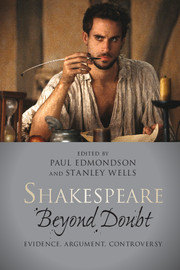Book contents
- Frontmatter
- Content
- List of illustrations
- List of contributors
- General introduction
- Part I Sceptics
- Part II Shakespeare as author
- 6 Theorizing Shakespeare's authorship
- 7 Allusions to Shakespeare to 1642
- 8 Shakespeare as collaborator
- 9 Authorship and the evidence of stylometrics
- 10 What does textual evidence reveal about the author?
- 11 Shakespeare and Warwickshire
- 12 Shakespeare and school
- 13 Shakespeare tells lies
- Part III A cultural phenomenon: Did Shakespeare write Shakespeare?
- Afterword
- A selected reading list
- Notes
- Index
10 - What does textual evidence reveal about the author?
from Part II - Shakespeare as author
Published online by Cambridge University Press: 05 April 2013
- Frontmatter
- Content
- List of illustrations
- List of contributors
- General introduction
- Part I Sceptics
- Part II Shakespeare as author
- 6 Theorizing Shakespeare's authorship
- 7 Allusions to Shakespeare to 1642
- 8 Shakespeare as collaborator
- 9 Authorship and the evidence of stylometrics
- 10 What does textual evidence reveal about the author?
- 11 Shakespeare and Warwickshire
- 12 Shakespeare and school
- 13 Shakespeare tells lies
- Part III A cultural phenomenon: Did Shakespeare write Shakespeare?
- Afterword
- A selected reading list
- Notes
- Index
Summary
A careful consideration of Shakespeare's dramatic texts reveals that their author was a professional man of the theatre who always wrote with a nuanced understanding of the specific requirements and limitations of his acting company. Many readers of Shakespeare may never have noticed that his plays are exquisitely structured to enable the practice of doubling – having individual actors portray more than one character. By this means, Shakespeare could write plays with as many as seventy speaking parts for a company that generally had no more than a dozen or so actors.
In order to facilitate this doubling of roles, Shakespeare constructed his plays with a meticulous oscillation of parts. In Hamlet, for instance, the thirty-one speaking roles could be performed by eleven actors (eight men and three boys), because characters such as Laertes and Guildenstern or the Ghost and Claudius never appear onstage together. Thus, one actor could begin the play as Laertes (who figures in 1.2 and 1.3) and then change costume to re-enter as Guildenstern in Acts 2 and 3 (in which Laertes does not appear). Guildenstern's role continues through the first three scenes of Act 4, after which Laertes returns at line 109.1 of 4.5 (the first hundred lines of dialogue would presumably have provided time for a costume change). Similarly, a single actor could play both the Ghost of Hamlet's father and Claudius: the Ghost appears in 1.1; Claudius in 1.2; the Ghost in 1.4; Claudius in 2.2–3.3. The Ghost reappears at line 93.1 in 3.4, then exits at 127.1; during the subsequent seventy lines of dialogue between Hamlet and Gertrude, the actor could change his costume in preparation for his entrance as Claudius at the opening of 4.1.
- Type
- Chapter
- Information
- Shakespeare beyond DoubtEvidence, Argument, Controversy, pp. 111 - 120Publisher: Cambridge University PressPrint publication year: 2013
- 1
- Cited by



